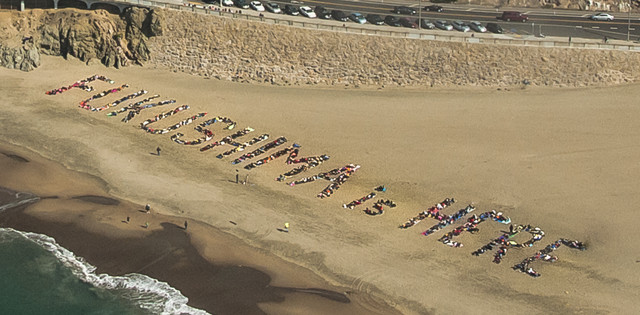
Advertisement
Last December, scientists detected the highest levels of radiation from the Fukushima disaster taken to date, off the coast of California. Now, researchers have released the results of a new study on just how long it took those radioactive particles to plague American shores.
According to the report of Canadian researchers in the Proceeding of the National Academy of Sciences, it took approximately 2.1 years for cesium-134 and cesium-137 from the Fukushima disaster to navigate across the Pacific Ocean and bombard the West Coast. During that time, a spike in beached marine life began to infest California’s shores. Meanwhile, the mainstream media’s coverage of the disaster fell virtually silent, claiming radiation levels did not pose a threat to public health.(1)
Cesium-134 has a half-life of about two years, whereas cesium 137- has a half-life of a little over 30 years. These radioactive elements did exist in the environment prior to the advent of nuclear weapons and, eventually, the nuclear tests and accidents that followed.(2)
“We had a situation where the radioactive tracer was deposited at a very specific location off the coast of Japan at a very specific time,” said John Smith of the Bedford Institute of Oceanography in Nova Scotia, who authored the study.(1)
“It was kind of like a dye experiment,” he added. “And it is unambiguous — you either see the signal or you don’t, and when you see it you know exactly what you are measuring,” he added.(1)
Don’t let disasters, both natural and unnatural, take you by surprise, by visiting Collapse.news, powered by Fetch.news.

Fukushima radiation reaches British Columbia less than two years after disaster
Smith and his team first started collecting samples of ocean water as far as 930 miles off the coastline of British Columbia in June 2011, three months after the Fukushima catastrophe. They then collected samples from the same sites every June until 2013.(1)
The samples taken in 2011 showed no traces of cesium from the Fukushima disaster. By 2012, however, traces of radiation were detected in the westernmost sampling site. By June 2013, the radiation had reached Canada’s continental shelf, note the researchers.(1)
A Becquerel (Bq) is the number of radioactive decay events per second for every 260 gallons of water. The amount of radiation detected by the researchers was relatively small, below 1 Bq per cubic meter. That level is at least 1,000 times lower than what the U.S. Environmental Protection Agency allows in public drinking water.(1)
The research reveals that radiation from the Fukushima disaster was able to spread out across the ocean far quicker than previous estimates suggest. Many figures indicated it would take at least four years for radiation to reach the West Coast, and it’s by no means dying down.
The highest record of radiation taken to date was discovered 1,600 miles west of San Francisco late last year. The amount of radioactive cesium detected in the samples was 11 Bq per cubic meter of seawater (264 gallons), which is 50 percent higher than other samples taken across the coast.(2)
No safe levels of cesium-134 or cesium-137
Although this is the highest sample taken to date, it is still 500 times lower than U.S. government safety limits for drinking water, which says more about government safety standards than it does about the purity of the water. In fact, ironically, following the Fukushima disaster, the federal government actually increased the amount of radiation permitted in citizens’ drinking water.(2)
Remember, there are no “safe” levels of radiation. Even small amounts of radiation can have an accumulative affect overtime, which can cause an onslaught of health problems in the long-term.
“[Cesium] levels in the eastern North Pacific from Fukushima inputs will probably return eastern North Pacific concentrations to the fallout levels that prevailed during the 1980s but does not represent a threat to human health or the environment,” the authors of the recent study wrote.(1)
Computer models and samples collected thus far predict that radiation levels off the coast of British Columbia will peak in 2016 and remain below 5 Bq per cubic meter.
Sources include:
(1) TechTimes.com
Submit a correction >>
This article may contain statements that reflect the opinion of the author
Advertisement
Advertisements















